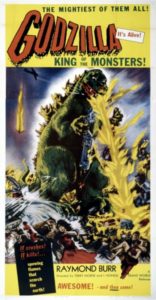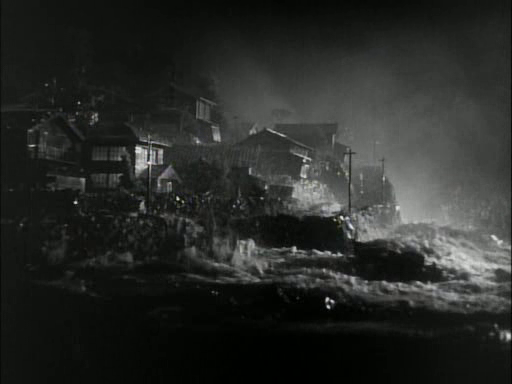Godzilla, King of the Monsters! (1956)
“Neither man nor his machines are able to stop this creature.”
|
Synopsis: |
|
Genres:
Response to Peary’s Review: Peary writes about the film at length in his Cult Movies 2 book, where he notes that “even with the popularity of campy (as in bad) movies, [he is] at a loss to explain the cult in American for Japanese monster movies”. He describes how beloved Godzilla — or Gojira — is in Japan, and cites Ed Godziszewski in noting it “is considered… by many to be the second greatest Japanese film ever made, next to Kurosawa’s The Seven Samurai” — and that because of its success, “Toho [Studios] produced a wave of science fiction and fantasy films until the mid-’70s”. Peary spends the bulk of his Cult Movies review comparing the two versions of the film (which have been re-released through Criterion with plenty of extras), noting inconsistencies and pointing out ways in which many (but not all) references to the A bomb were deleted in the Americanized version. In GFTFF, Peary concludes that “The Honda version ends gloomily, the Morse version optimistically” — but adds that “only Honda’s version makes a plea for peace and no more bomb-testing”. Note: As a major cult movie, Godzilla has many fans who have written volumes about it and its many sequels (see Moria’s review for a run-down). Redeeming Qualities and Moments: Must See? Categories
Links: |




5 thoughts on “Godzilla, King of the Monsters! (1956)”
The 96 minute Japanese version is superb; like a monster film directed by Kurosawa.
I saw it on the big screen at the Bradford Science and Media Museum about a decade ago. Scientifically it’s daft as a brush, but the script, direction and actors treat the material seriously.
It also opens with a fictional version of the Luck Dragon incident, where several Japanese fishermen were contaminated by US nuclear bomb testing. In the film this leads to Gojira (the proper name) rising.
It has such a graphic, serious edge and is highly critical of the US using atomic bombs … material cut from the bastardised US edit.
The equal of King Kong (1933).
It’s a shame that Peary hasn’t been able to review all of the Godzilla films in the original production sound Japanese, uncut and in their widescreen ratios. And in the case of some of them, with the original stereo sound (King Kong Vs. Godzilla).
In Japan they were prestigious, big budget family films and are colourful, imaginative and highly enjoyable. They did get a little too silly in the ’70s but are never less than entertaining.
Godzilla Vs. Hedorah (1971), known in English speaking territories as Godzilla Vs. the Smog Monster was heavily influenced by Rachel Carson’s The Silent Spring (1962) and actually has animated educational segments. It’s wonderful, loopy fun and as a kid open ed my eyes and mind to polution and conservation.
A once-must, at least, for its place in cinema history – though old-style monster movie fans may give it repeat viewings. When I was a kid, the 1956 Americanized version was quite often screened on tv and I recall seeing it several times. My sense tells me that I wouldn’t particularly care to revisit that version since I find the 1954 original much more satisfying. That’s the version I would recommend to first-time viewers. As per my post in ‘Revival House of Camp and Cult’ (fb):
“I barely escaped the atomic bomb in Nagasaki – and now *this*!”
‘Godzilla’ (1954) [on FilmStruck]: It might be interesting to play this back to back with the 1956 American version known as ‘Godzilla, King of the Monsters’. That’s the only version I knew until now: and, as many know, the latter version stripped 20 minutes of the original (mainly its political / nuclear content) and edited in Raymond Burr (himself and doubles). Who knows the real reason for the radical change – except… ‘Godzilla’ had not been a hit in Japan (audiences and critics thought it was nonsense). In the ’50s, little attention was paid to Japanese film in general (until Kurosawa changed that with ‘Rashomon’) and, besides, the US distributor (Joseph E. Levine) may have been nervous and guilt-ridden about the film’s content re: the atomic bomb. At any rate, emphasis was placed on making Godzilla the Japanese equivalent of King Kong. In the US, the film was a hit… and it was only from then on that Japanese audiences and critics changed their minds about the initial film and began to praise it. Surprisingly, the original (which could arguably still be the best in the lengthy series) often feels less like a monster movie than a regular drama… with a monster thrown in. (By the way, a brand-new American Godzilla movie opens in May of next year.)
It was more like 30-40 minutes stripped out of the original.
It ran 96 minutes, the American version only 81 minutes inclusive of all the added Raymond Burr scenes.
Easily a must see but only in the 96 minute Japanese version.